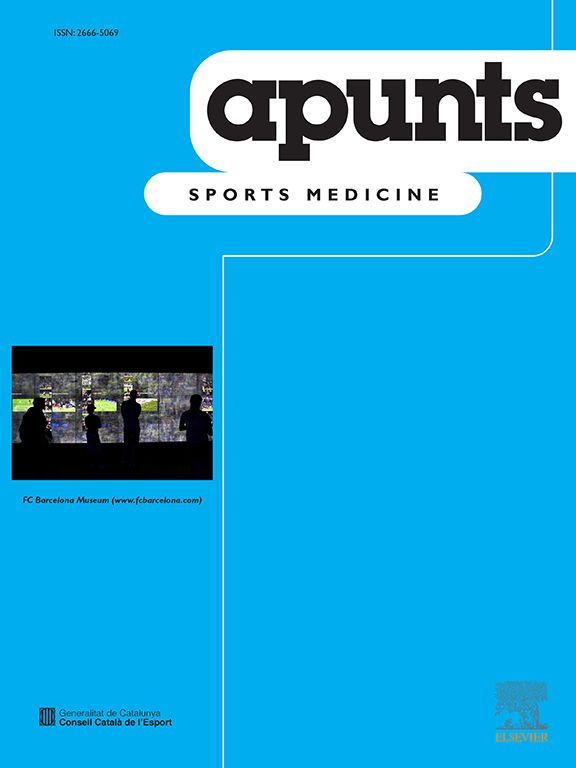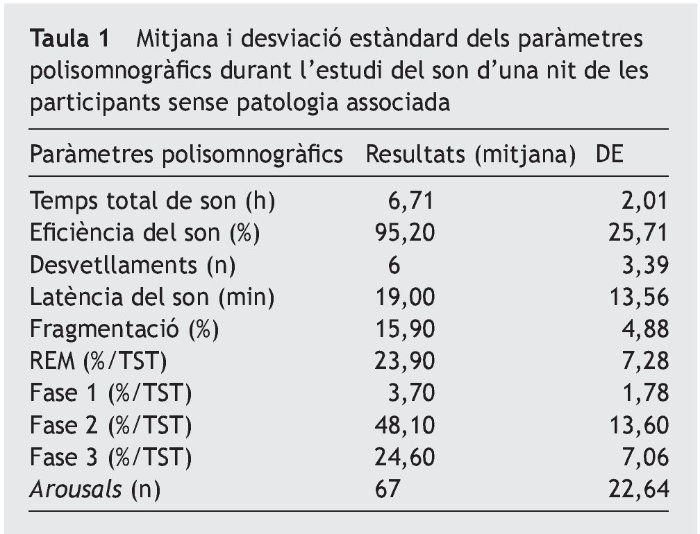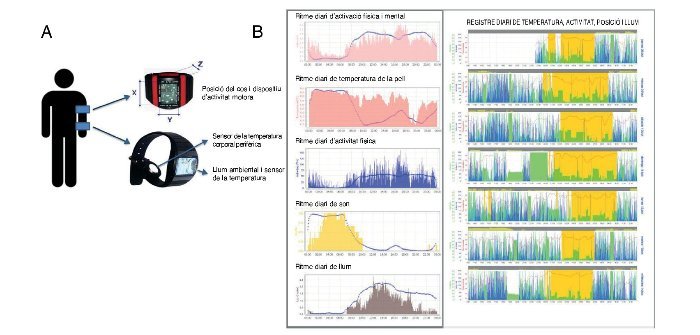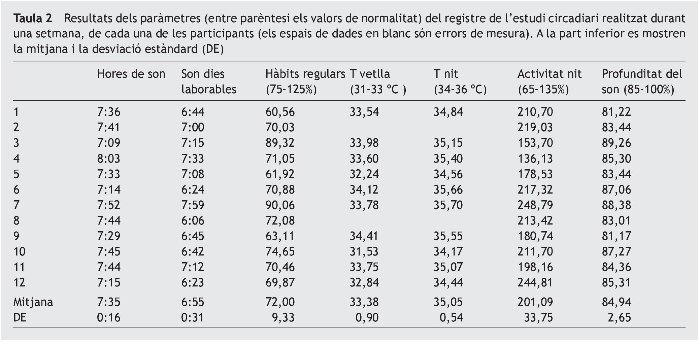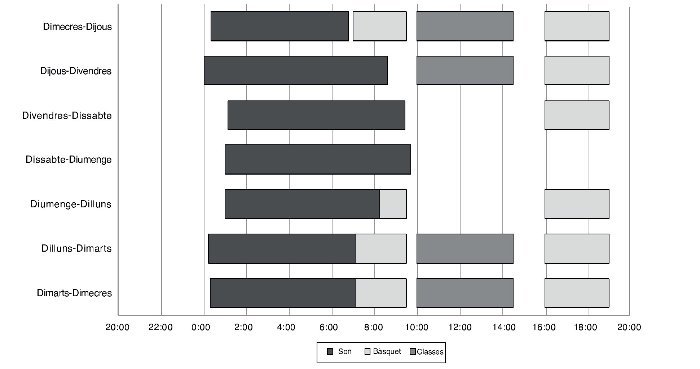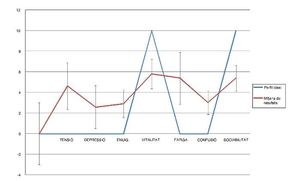Introducció: L’objectiu de l’estudi fou avaluar el son, els ritmes circadiaris i l’estat neurocognitiu d’esportistes d’alt rendiment durant el període habitual d’entrenament, competicions i estudis.
Material i mètode: S’avaluà un equip de 12 jugadores (dones, 15-17 anys) de bàsquet d’alt rendiment, concentrat en una residència d’esportistes. S’estudià el son mitjançant polisomnografia, els ritmes circadiaris mitjançant sensors de monitoratge circadiari ambulatori, i l’estat neurocognitiu mitjançant una bateria de qüestionaris.
Resultats: Les esportistes dormen 6:57 ± 0,02 h; l’activitat nocturna, del 201,1 ± 33,7%, se situa per damunt de la normalitat (65-135%); la regularitat d’horaris, d’un 72,6 ± 9,2%, també està fora del rang normal (75-125%). La profunditat del son, del 85,1 ± 2,6% (valors normals entre 85-100%), és reduïda, i la temperatura perifèrica elevada durant el dia, de 33,4 ± 0,9 ºC (valors normals entre 31-33 ºC), indica somnolència.
Conclusions: Les esportistes del nostre estudi dormen menys hores de les necessàries, la qualitat del son és baixa, degut a la fatiga muscular i a uns mals hàbits, i els horaris irregulars deterioren el sistema circadiari. Tot això influeix en el rendiment, tant físic com mental. És basic conscienciar el col·lectiu, amb tots els estaments implicats, de la importància de millorar aquests hàbits de son a fi de mantenir el rendiment físic òptim.
Introduction: The objective of the study was to evaluate sleep, circadian rhythms and neurocognitive status of high performance athletes during the usual period of training, competitions and studies.
Material and method: A team of 12 high-performance basketball players (women, 15-17 years old) concentrated in a sports residence was evaluated. Sleep was studied through polysomnography, circadian rhythms using ambulatory circadian monitoring sensors, and neurocognitive status using a battery of questionnaires.
Results: Athletes sleep 6:57 ± 0.02 h, nocturnal activity of 201.1 ± 33.7% is above normal range (65-135%), regularity of schedules, 72.6 ± 9.2% is also out of range (75-125%). The sleep depth of 85.1 ± 2.6% (normal values between 85 and 100%) is reduced, and the peripheral temperature during the day, of 33.4 ± 0.9 ºC (normal values between 31 and 33 ºC), indicates drowsiness.
Conclusions: Our sample of athletes sleep less than the necessary hours, their sleep quality is low due to muscle fatigue and poor habits, and their irregular schedule deteriorates the circadian system. All of this influences both physical and mental performance. It is essential to raise awareness of the importance of improving these sleep habits in order to maintain optimum physical performance.
Introducció
L’evidència científica demostra que un dels principals factors que influeixen en el rendiment esportiu és la qualitat i la quantitat d’hores que dormen els esportistes1.
El desenvolupament i el rendiment esportius es basen principalment en l’entrenament, tot i que també són importants altres factors d’«entrenament invisible». Aquests factors inclouen la recuperació física, la preparació psicològica, la nutrició i també el descans. Un son adequat juga un paper molt important en el rendiment esportiu i en la recuperació física, fisiològica i metabòlica, alhora que també garanteix un bon estat cognitiu i anímic.
Tanmateix, la pròpia disciplina dels esportistes porta implícita una reducció de les hores de son, problemes de la qualitat del descans i un deteriorament dels ritmes circadiaris2-6. Els horaris d’entrenament, les competicions i l’estrès i l’ansietat que comporten, l’alt grau d’esgotament físic i el sobreentrenament afecten el descans. Aquest desgast i la mala qualitat del son impedeixen la reparació necessària, que afecta la recuperació física i mental.
Nombroses publicacions estudien com la manca de descans afecta la recuperació i el rendiment físic. Skein et al.7 associen la manca de son a una reducció dels nivells de glucogen muscular, i com a conseqüència, amb un menor rendiment en competicions esportives realitzades; VanHelder et al.8 insisteixen en la relació entre la privació del son i un augment de la demanda metabòlica i un major consum energètic. De la mateixa manera, la recuperació es torna menys efectiva degut a un augment del consum energètic i la demanda metabòlica9,10. Finalment, també s’ha relacionat la falta de son amb el factor més important de risc de patir lesions, augmentant el risc de lesió 1,7 vegades, segons un estudi realitzat amb 160 esportistes adolescents11.
Els ritmes circadiaris estan determinats genèticament per la naturalesa de cada individu, i influeixen en la variabilitat del rendiment durant el dia12. És molt important preservar els ritmes circadiaris per conservar l’equilibri homeostàtic, que està relacionat directament amb les funcions mentals i físiques, la funció cardiovascular, la temperatura central o el metabolisme. Caldria adaptar els horaris d’entrenament al cronotip de cada esportista.
La influència de la manca de descans no és menys important en l’estat anímic i cognitiu. La relació amb la percepció de fatiga, la resistència a l’estrès, la capacitat de treball, el temps de reacció i la concentració es veu afectada per la manca de son13.
Un treball directament relacionat amb aquest estudi fou publicat per Mah et al.14. En aquest s’hi estudia l’efecte de l’extensió del son sobre el rendiment d’un equip de jugadors de bàsquet de la Universitat d’Stanford. Amb una durada de 7 h i 45 min, mitjana inicial, a les 9 h i 15 min, s’observaren millores significatives en totes les proves de rendiment esportiu: més rapidesa en la cursa cronometrada, una major precisió en tirs lliures a la cistella i triples, juntament amb una millor valoració subjectiva del rendiment esportiu. De la mateixa manera, en diferents tests les jugadores van expressar nivells més baixos de somnolència (test d’Epworth), un millor perfil d’humor, menor fatiga i major vitalitat (test de POMS), juntament amb una disminució del temps de reacció (test PVT).
Aquest article estudia el son d’un equip femení de bàsquet d’elit, abordant novament l’estudi del son per aportar més dades científiques sobre la qualitat i la quantitat del seu descans. Per primera vegada, s’analitza el son objectivament mitjançant un monitoratge circadiari ambulatori (MCA). Això ens permet analitzar objectivament les hores de son, la seva qualitat, els desvetllaments nocturns, els hàbits quotidians, la temperatura corporal i els ritmes circadiaris, entre altres paràmetres. A més, es va utilitzar una bateria de qüestionaris per avaluar les condicions neurocognitives de les participants.
Les dades obtingudes permetran conèixer les hores de son i la qualitat del son. També es podran detectar possibles patologies, avaluar els hàbits del son i la influència de l’entorn per a una bona qualitat del descans.
Material i mètode
Es realitzà un estudi observacional d’un equip de 12 jugadores (dones de 15 a 17 anys) de bàsquet d’alt rendiment (amb el consentiment signat dels seus pares o tutors), concentrat en una residència d’esportistes (Residència Blume, Esplugues de Llobregat). S’estudià el son de cada participant mitjançant polisomnografia durant una nit, a les habitacions habituals de la mateixa residència. També es van estudiar el seus ritmes circadiaris amb sensors de cronobiologia, que portaven com a rellotge durant les 24 hores del dia, durant 7 dies d’activitat habitual. Finalment, s’utilitzà una bateria de qüestionaris per avaluar l’estat psicològic i neurocognitiu de les participants.
Polisomnografia
El registre de la polisomnografia (Clínica de Sueño Dr. Estivill, Barcelona) es realitzà durant una nit normal del subjecte a la seva habitació habitual (residència d’esportistes); s’analitzà l’arquitectura del son de cada participant per detectar possibles patologies del son que poguessin interferir el repòs nocturn dels subjectes (apnea/hipopnea, moviments periòdics de les extremitats o parasòmnia).
L’activitat cerebral es va registrar mitjançant elèctrodes de contacte, seguint les tècniques establertes per l’American Academy of Sleep. L’activitat electromiogràfica (EMG) es mesurà aplicant elèctrodes a la regió submentoniana i als músculs tibials anteriors. S’utilitzà un sensor de posició corporal. També es registrà el ritme cardíac. Els moviments oculars (EOG) es mesuraren mitjançant dos elèctrodes situats prop dels ulls. S’utilitzaren resistències tèrmiques de nas i boca i un transductor de pressió, així com tires d’inducció abdominal i toràcica per analitzar la dinàmica respiratòria. El flux nasal i la saturació d’oxigen de la sang (SaO2) es mesuraren per oximetria de pols. Les dades polisomnogràfiques van ser adquirides simultàniament a través de 15 canals diferents a 30 s per pàgina, durant 8 h.
Estudi circadiari
Els ritmes circadiaris i el cicle del son/vigília de les participants es van estudiar amb un dispositiu de monitoratge circadiari ambulatori (MCA) (Kronowise®, Chronolab, Universitat de Múrcia) multicanal, que consisteix en: a) un rellotge de polsera que inclou un sensor de temperatura (Thermochron® iButton DS1921H, Dallas, Maxim) per registrar la temperatura distal del cos (ºC) com a indicador indirecte de somnolència15 i un sensor de temperatura ambient (Hobo® PendantTemp/Light Data Logger) (ºC) i sensor de llum (lx); b) un actímetre (Hobo® Pendant G Acceleration Data Logger) com a braçalet que registra l’acceleració (m/s2) i la posició estàtica (º) en tres eixos, per avaluar els ritmes de repòs/activitat.
Els sensors es van portar les 24 h del dia, durant 7 dies, amb hàbits diaris normals. Les variables de posició, activitat i llum es van registrar cada 30 s i la temperatura corporal es va registrar cada 10 min.
Les dades s’analitzaren mitjançant el programari Circadianware® (Chronolab, Universitat de Múrcia), i es mostrà la mitjana de la temperatura corporal individual, la llum i els paràmetres d’activitat durant els 7 dies, i es van comparar amb els valors estàndard d’una població normal.
El càlcul algorítmic de temperatura corporal (T), activitat motora (A) i posició (P) donà com a resultat la variable integrada TAP16; es tracta d’una estimació del nivell d’activació que permet inferir períodes de son o vigília. Els nivells de TAP elevats corresponen a baixes temperatures corporals, amb alts valors d’activitat i posició, que representen períodes amb un alt nivell d’activitat física i mental (vigília). Un nivell de TAP baix correspon als nivells d’alta temperatura i baixos nivells d’activitat i posició, que són valors típics del son.
L’anàlisi de les dades registrades pels sensors ofereix un ventall d’indicadors sobre el son i els ritmes circadiaris: hores de son, temperatura mitjana durant la nit, com a indicador de profunditat del son, temperatura mitjana durant el dia, indicador de vigília o somnolència, activitat durant la nit, com a indicador del fraccionament, profunditat del son, els hàbits habituals per avaluar els ritmes circadiaris, l’estabilitat interdiària (EI), associats a la regularitat del cicle de son i vigília, entre diferents dies, la fragmentació intradiària (FI) de les variables registrades, l’amplitud interdiària (AI) segons el contrast de les variables entre la vigília i el son, i el funcionament circadiari del cicle de vigília/son (CFI) com a valor global de la robustesa dels ritmes circadiaris.
Bateria de qüestionaris
Les participants van completar la següent bateria de qüestionaris: es mesurà el nivell de somnolència subjectiva, mitjançant el test de somnolència Epworth17, que utilitza una escala entre 0 a 24, essent el 9 el valor que mostra la màxima normalitat. L’escala matutina composta (EMC)18 mesurà el cronotip o el perfil genèticament determinat per a ser vespertí o matutí que condiciona el rendiment físic de cada esportista en els horaris de l’entrenament. Les funcions executives s’avaluaren utilitzant el test de Senders TESEN (JA Portellano, R. Martínez Arias, TEA ediciones, Madrid), qüestionari estandarditzat derivat de la TMT19, que es basa en la capacitat de planificació visual. Es mesurà el temps de realització i la quantitat d’errors comesos.
Es realitzà el perfil d’estats d’humor (POMS)20 per determinar els 7 perfils: tensió, depressió, enuig, vitalitat, fatiga, confusió i sociabilitat. Aquesta eina és àmpliament utilitzada a l’àmbit esportiu, en què s’observa que els estats d’ànim negatius són més reduïts en comparació amb la població normal, mentre que el vigor és més elevat21. Aquest perfil, característic dels esportistes, segueix el denominat model Iceberg, que es veu afectat pel sobreentrenament i la fatiga22.
Resultats
La mitjana d’edat de les participants de l’estudi fou de 16 ± 0,8 anys, amb un pes mitjà de 69 ± 7,1 kg, 185 ± 6,1 m d’alçada i un IMC de 20,7 ± 1,1.
Segons els resultats del qüestionari del cronotip CMS, s’observà que 6 jugadores tenien el perfil matutí (barem entre 36-55), 2 tenien un perfil vespertí (barem entre 13-26), mentre que les altres tenien un cronotip intermedi. El qüestionari de somnolència d’Epworth donà una puntuació subjectiva mitjana de somnolència de 9 (valor límit de la normalitat), mentre que el 54% dels subjectes declararen que tenien excés de son (amb una puntuació superior a 9). Durant l’estudi s’observà un nivell de lesions elevat, i que aquestes lesions afectaven el 75% de les participants.
Resultats de la polisomnografia
Els estudis de polisomnografia detectaren un registre patològic a causa de l’insomni psicofisiològic (cas 1), un cas d’hipopnea postural (cas 6) i un cas de moviments excessius de les extremitats (mioclònia, cas 12). A la taula 1 es mostren els valors mitjans obtinguts dels 9 registres normals: l’estructura del son segons els percentatges de les diferents fases del son es troba dins dels límits de la normalitat, tot i que la durada mitjana total del son fou curta, amb un alt nivell de latència i un nombre d’arousals (o microdespertars) excessiu.
Resultats de l’estudi circadiari
L’enregistrament diari, durant 7 dies, de les variables T, A, TAP del son i la llum proporciona informació sobre el nombre d’hores que dormen i la profunditat del son. També s’observen els ritmes circadiaris de vigília/son, segons la regularitat dels seus hàbits. Els resultats també es van comparar amb els corresponents a una població normal, mitjançant la representació gràfica de les mitjanes setmanals de les variables.
La figura 1 mostra un exemple d’aquest tipus de registre. Les hores de son, durant els diferents dies, són irregulars, a causa dels mals hàbits. Hi ha un alt nivell d’activitat al principi de la nit a causa de la dificultat d’agafar el son, i la temperatura elevada durant el dia és un reflex de la somnolència.
Figura 1. A) Esquema de la col·locació dels sensors de monitoratge circadiari ambulatori. B) Exemple de representació gràfica de l’estudi cronobiològic durant 7 dies. Esquerra: representació gràfica de la mitjana setmanal de les variables TAP, temperatura, activitat física, son i llum (àrees de color), comparades amb els valors estàndard de la població sana (línies blaves). Dreta: representació gràfica de les variables d’activitat (blau), posició (verd) i temperatura (línia vermella) d’una persona, registrades durant 7 dies. El càlcul de la durada del son, marcat per la franja groga, es caracteritza per una temperatura alta, moviments reduïts i una posició baixa. Els episodis de desvetllament durant el son es caracteritzen per moviments de posició i baixada de la temperatura.
La taula 2 mostra els resultats dels estudis circadiaris de totes les participants, juntament amb la mitjana de cadascun dels paràmetres calculats. En general, s’observà que el nombre d’hores dormides durant tota la setmana (7:35 h) és inferior a les necessitats, donada l’edat de les participants, i es redueix encara més si es consideren només els dies laborables (6:55 h). Això s’associa amb la somnolència que pateixen durant el dia, detectada per una temperatura generalment elevada (temperatura de vigília: 33,38 ºC) comparada amb el valor normal de 31-33 ºC. També es detectà una activitat desmesurada durant la nit (201,09%), en comparació amb els valors normals (65-135%). Això fou degut a un son fraccionat, cosa que provoca un son poc reparador. Finalment, la regularitat dels hàbits (72%) i la profunditat del son (84,94%) són inferiors als normals d’una població sana (75-125% i 85-100%, respectivament). Aquestes alteracions s’associen a un cert grau de disrupció dels ritmes circadiaris.
La taula 3 mostra altres paràmetres indicatius del funcionament circadiari de les variables registrades. Els nivells baixos del paràmetre EI (índex de regularitat) indiquen que els ritmes de T, TAP i son durant tota la setmana no es mantenen estables dia a dia, a causa dels mals hàbits circadiaris. El mateix es pot concloure a partir dels baixos valors del paràmetre CFI, que és un reflex de la mala qualitat circadiària dels seus horaris. Els valors elevats de FI mostren la inestabilitat de les variables durant 24 h, cosa que indica que el son està fragmentat. L’amplitud relativa (AR) de la variable temperatura és baixa, degut a la poca diferència entre la temperatura diürna (que és anormalment alta a causa de la somnolència) i la temperatura nocturna.
Els horaris de son estan completament associats a les seves activitats i obligacions durant la setmana. Observem a la figura 2 com es redueixen les hores de son durant la setmana: s’aixequen molt d’hora per anar a entrenar però se’n van a dormir tard a la nit, cosa que els impedeix que dormin les hores necessàries. En canvi, durant el cap de setmana s’observa de forma generalitzada un retard del ritme vigília/son, cosa que provoca una desincronització del ritme circadiari entre el cap de setmana i els dies entre setmana, fenomen conegut com a jet-lag social.
Figura 2. Representació gràfica de la mitjana dels horaris de son (barres negres), entrenament de bàsquet (barres grises) i classes (barres de color gris fosc) de totes les jugadores durant la setmana.
Figura 3. La gràfica mostra la mitjana de resultats del qüestionari POMS, comparat amb el perfil ideal (Iceberg).
Resultats de la bateria de qüestionaris
El qüestionari de l’estat d’ànim (POMS) es compara amb el perfil Iceberg típic de l’esportista d’elit. Els resultats de la corba mitjana de les esportistes d’aquest estudi (fig. 3) evidencien nivells de tensió excessivament elevada, depressió, confusió i fatiga, juntament amb una reducció de la vitalitat.
El dèficit crònic de son que pateixen les participants podria traduir-se en la inestabilitat anímica que mostren, i també s’associa a una falta de recuperació física.
La mitjana de resultats del qüestionari sobre funcions executives (TESEN) foren correctes, en termes d’execució i velocitat, en percentils 85 i 90%, respectivament. Tanmateix, la puntuació mitjana de precisió, en el percentil 30%, és normal-baixa, cosa que s’associa a una flexibilitat mental insuficient, a una impulsivitat excessiva i a dificultats en la memòria de treball, junt amb altres factors emocionals i motivacionals.
Discussió
Amb l’estudi polisomnogràfic, monitoratge circadiari durant una setmana i bateria de qüestionaris podem extreure algunes conclusions sobre el son de les jugadores, els seus hàbits, ritmes circadiaris, qualitat del descans i conseqüències de la somnolència i estat d’ànim.
Esportistes de l’edat com les del grup d’estudi haurien de dormir almenys 9 h diàries. No obstant això, hem observat que els horaris d’entrenament i estudi els dificulta que dormin les hores necessàries. En general, pateixen una privació de son crònica, que s’agreuja molt els dies laborables. El cap de setmana intenten recuperar, però retarden l’horari de son, cosa que origina una desincronització del ritme circadiari.
També vam constatar una mala qualitat del son. L’activitat durant el son és excessiva, cosa que pot ser deguda a la fatiga muscular acumulada durant el dia. Això comporta un son fraccionat, no reparador. A més, l’entorn de la residència, amb habitacions compartides i espais comuns, impedeix un silenci absolut i la foscor durant la nit, cosa que, alhora, els provoca un retard a l’hora d’anar a dormir. Les rutines i els hàbits del son es veuen afectats per l’entorn social i la variabilitat dels horaris. Els ritmes circadiaris desincronitzats contribueixen a mantenir les pertorbacions del son observades.
La manca i mala qualitat del son comporta somnolència durant el dia, constatada per una temperatura excessivament elevada. Això pot condicionar un rendiment inferior al que s’esperaria del nivell d’aquestes esportistes. Vam observar un estat anímic afectat per la fatiga, cosa que repercuteix en la gestió emocional de les jugadores a l’equip.
L’evidència científica constata la importància de preservar les hores i la qualitat de son dels esportistes. Caldria que fos considerat com a part del seu entrenament invisible, necessari per aconseguir la reparació física que els cal per mantenir el rendiment esportiu òptim, així com per generar una bona estabilitat emocional i cognitiva. Cal una bona qualitat del son, amb un horari estable i bones rutines de son, juntament amb un entorn favorable per assegurar la qualitat del descans.
Tanmateix, la manca de son, en aquest grup d’esportistes estudiades, evidencia que cal incorporar estratègies que permetin millorar en aquest sentit. De fet, la deficiència de son s’ha observat prèviament en esportistes de diferents disciplines. És fonamental que tots els estaments implicats en l’entrenament esportiu donin la importància necessària al descans nocturn. El son i l’estat físic i mental de les esportistes està degradat, de manera que, tal com s’ha publicat, es correlaciona amb un rendiment esportiu menor i un augment de la probabilitat de lesions. Dormir més és, per tant, una condició fonamental per millorar el rendiment.
Finançament
Treball finançat pel Consell Català de l’Esport de la Generalitat de Catalunya (PRE/1278/2015).
Conflicte d’interessos
Els autors declaren que no tenen cap conflicte d’interessos.
Rebut el 20 de setembre de 2017;
acceptat el 16 d’octubre de 2017
☆ Treball presentat a la XXIVa reunió anual de la Sociedad Española del Sueño (Valladolid, 31 de març-2 d’abril de 2016)
* Autor per a la correspondència.
Correu electrònic: carla@doctorestivill.es (C. Estivill-Domènech).

